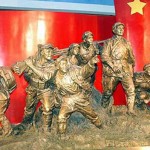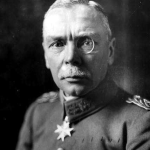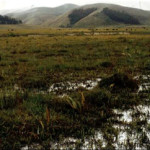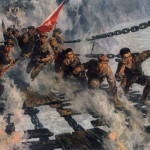
The Long March refers to the relocation of the Chinese Communist Party (CCP) and its Red Army, from their base in Jiangxi to the northern province of Shaanxi in 1934-35. Driven from Jiangxi by an expanded Nationalist army, the Red Army and the CCP leadership undertook a treacherous year-long journey through western and northern China. During this trek, they encountered dangerous terrain, perilous climate, starvation, disease, harassment from warlord armies and hostile tribes, as well as frequent exchanges with the Nationalist army. The Long March was not one single march but a series of marches, undertaken by several branches of the Red Army. It was completed almost entirely on foot and took a year to complete. The journey spanned around 3,700 miles or 6,000 kilometres – the equivalent of walking return trips from Paris to Moscow, Chicago to Las Vegas or Sydney to Cairns.
Approximately 160,000 Red Army soldiers and CCP cadres embarked on the Long March. Fewer than 15,000 made it safely to Shaanxi. The enormity of these losses, by any reasonable measure, suggest the Long March was a failure. It was a military retreat, carried out with little or no forward planning, which resulted in the loss of more 90 per cent of the Red Army. But CCP propagandists manufactured their own account of the Long March, portraying it as a tale of inspiring heroism, human endeavour and self-sacrifice. The official histories of the party hailed the Long March as a victory rather than a defeat. They attributed its strategic and military successes to Mao Zedong, who during the course of the Long March seized control of the expedition from Bolshevik loyalists. The Long March became most mythologised and propaganda laden event in the history of the CCP. It also marks the beginning of Mao’s ascendancy to the party’s national leadership.

The story of the Long March begins with the Nationalists’ Fifth Encirclement Campaign, launched in September 1933. Jiangi Jieshi’s four previous attempts to surround and disperse communist bases in the south (1930-33) had failed for several reasons. The Central Plains War (1930) had preoccupied Nationalist forces and left the government short of resources, while guerrilla strategies implemented by Mao Zedong in Jiangxi allowed the Red Army to withstand the first offensives. By 1933, however, the government was prepared for another assault in Jiangxi, Hubei and Henan. Jiang’s strategy changed after the October 1933 arrival of the German military advisor Hans von Seeckt. A veteran of World War I and one of Germany’s most competent generals, von Seeckt became Jiang’s most influential military counsellor. Von Seeckt urged Jiang to make sweeping changes to the organisation of his military and the industrial sector that supported it. On von Seeckt’s advice, Jiang mobilised more than 500,000 Nationalist soldiers and negotiated military alliances with warlords, bringing anti-communist troop numbers to over one million. These forces surrounded the communist bases in the south and constructed thousands of small fortifications. Rather than engaging with the communist Red Army, Jiang’s forces prepared for a long war of attrition.

Compounding the change in Nationalist tactics were internal power shifts within the Jiangxi Soviet. Since 1930 Mao Zedong had been the de facto military and political leader in Jiangxi. This changed in 1932 when the CCP Central Committee arrived from Shanghai. Control of Jiangxi was assumed by the party’s national leadership and by the so-called 28 Bolsheviks, a clique of CCP leaders loyal to ideological and tactical advice from the Comintern. Despite his success in establishing and defending the Jiangxi Soviet, Mao was sidelined and his military tactics were reviewed and changed. The CCP leadership, overconfident and lacking an understanding of the situation, believed the Red Army was ready to wage a conventional war. But despite its recent growth and improvement, the Red Army remained hopelessly outnumbered by Nationalist forces. When the Fifth Encirclement Campaign commenced in the autumn of 1933, the communists in Jiangxi were blockaded by 60 divisions of Nationalist troops and starved of information and supplies from other provinces. Jiang’s men secured the border regions and captured stronghold towns one by one, a tactic that gradually reduced the size of the Jiangxi Soviet. By mid-1934 the Nationalists were planning a mass assault on Ruijin, the Jiangxi capital. When CCP spies inside the Nationalist camp reported this to party leaders, they decided to abandon Jiangxi and relocate to the comparative safety of northern China. The main Red Army mobilised to leave Jiangxi, while the Fourth Red Army in Henan and the Second Red Army in Hubei made similar preparations.
“The March became a classic triumph of survival, a picture of stirring memories with 11 provinces spanned, 18 lofty mountains scaled, 24 wide rivers crossed, enemy points stormed by a few commandos, river rafts navigated under heavy fire, rocky cliffs climbed in midnight blackness, a forced march of 80 miles in 24 hours, a struggle through snow blizzards over lofty passes. The Red Army’s Long March bears a romantic history and in China today, its legends are more potent than all the talks by persuasive or threatening cadres.”
Khoon Choy Lee, historian
In October 1934 the Jiangxi column of more than 97,000 communists, one-tenth of whom were party officials and civilians, prepared to break through Nationalist lines at Yudu, west of Ruijin. The marchers carried whatever could be carried: typewriters, desks, furniture, printing presses, chests of currency, more than two million rounds of ammunition. They had neither a predetermined route or a set destination, Shaanxi being one option among others. The breakout from Jiangxi succeeded but came at a considerable human cost. The Red Army pushed west but endured air attacks from Jiang Jieshi’s 200 planes, along with assaults from small Nationalist and warlord brigades. By November the Red Army had crossed into Hunan province, where they encountered a sizeable force of Nationalist troops. In the Battle of Xiang River which followed, the communists lost 40,000 soldiers in just two days, its single greatest defeat during the Long March. By mid-December, the Red Army, which had set out from Jiangxi with around 86,000 men, was down to around 30,000. These disastrous losses forced the party to review its tactics, at a conference held in Zunyi in January 1935. The Zunyi conference was a pivotal moment in the history of the CCP. Red Army commanders were replaced with a new trio of Mao Zedong and his allies, Zhou Enlai and Wang Jiaxiang. Two years after being shelved by the party hierarchy in Jiangxi, Mao was now more prominent and powerful than ever.
After Zunyi the Red Army marched on into western China. Now in command of strategy, Mao sometimes ordered unlikely or circumlocutious routes to evade or confuse the Nationalists and their warlord allies. Travelling through Yunnan and into Sichuan the Red Army crossed the Great Snowy Mountains, a region many veterans later described as the worst part of the Long March. Facing mountainous heights of up to 5,000 metres and low oxygen concentration, thousands of Red Army soldiers died from altitude sickness, exposure, frostbite, avalanches, falls and other injuries. Thousands more were killed while moving through the dreaded ‘grasslands’: stinking swamps and bogs near the Tibetan border. Though seemingly innocuous the grasslands also proved deadly, as recalled by Long March veteran Xie Fei:
“That damn place was really strange. Just grass, no trees. It wasn’t mountainous, just flat land. It rained every day and the sun came out every day. The ground was all wet. At first, the vanguard troops sank into the bog. If you tried to pull them out, you would sink too. They couldn’t climb out and they couldn’t be rescued either. You could only watch them die. Once we learned this lesson we let the animals walk first. If the animal sank then the people wouldn’t die. What a weird place.”
Mao’s unpredictable routes also took the Long Marchers into the far west of the country, where they encountered hostility from ethnic groups like Tibetan tribesmen and the Hui (ethnic Chinese Muslims). But the communists also benefited from the support given by sympathetic farmers, who welcomed the Red Army into their villages, gave them food and tended their sick and wounded. Where peasants were less compliant the Red Army often stole food or demanded it through extortion, threats and kidnapping. There were also reports of the Red Army replenishing its numbers by conscripting young male peasants and forcing them to join the Long March. In less populated regions the Red Army often found itself chronically short of food. Frequent shortages gave rise to malnutrition and starvation. Marchers sometimes boiled boots, gun straps and other leather to make ‘beef soup’. When they had no freshwater they sometimes drank their own urine.

For the first Red Army, this ordeal ended in October 1935 when Mao led barely 8,000 people into Shaanxi province. Of the 160,000 men and women who participated in the Long March, fewer than 10 per cent made it safely to the new communist base in Shaanxi. More than 40,000 soldiers were lost in the Battle of Xiang River alone. The rest succumbed to other Nationalist, warlord or tribal attacks, to accidents, illnesses or malnutrition, or to desertion. By most measures, the Long March was a catastrophic failure, a string of military defeats and poorly planned withdrawals that decimated the Red Army. But Mao Zedong, acutely aware of the value of propaganda, set about transforming it from a defeat into a victory. Under Mao’s leadership, the story of the Long March was told in the party’s own terms and incorporated into its political and cultural history. According to this history, the events of 1934-35 marked the CCP’s lowest period – but also its rebirth and rejuvenation. The leadership of Mao and the courage of Red Army soldiers, who were hailed as heroes and martyrs, was pivotal to this rebirth. These perspectives were later echoed by Western writers, like Agnes Smedley (China’s Red Army Marches, 1934) and Edgar Snow (Red Star over China, 1937). Mao later explained the importance of the Long March as a propaganda device:
“The Long March is a manifesto. It has proclaimed to the world that the Red Army is an army of heroes, while the imperialists and their dogs are impotent. It has proclaimed their utter failure to encircle, pursue, obstruct and intercept us. The Long March is also a propaganda force. It has announced to some 200 million people in eleven provinces that the road of the Red Army is their only road to liberation. Without the Long March, how could the broad masses have learned so quickly about the existence of the great truth which the Red Army embodies? The Long March is also a seeding machine. In the eleven provinces, it has sown many seeds which will sprout, leaf, blossom, and bear fruit, and will yield a harvest in the future.”
The creation of this Long March “propaganda force” required a considerable amount of manipulation and distortion. Official CCP histories of the Long March are riddled with gross exaggerations, unverified accounts and one-sided interpretations. In recent times historians have sought to penetrate this propagandist veneer, to discover the realities of the Long March – but access to information, evidence and witnesses is difficult. Still, some historians have found enough evidence to raise significant questions. One significant point of contention is the events at Luding Bridge, a crossing over the Dadu River just west of Yan’an. According to official communist histories, Luding Bridge was the scene of a fierce battle with Nationalists in May 1935. Under heavy fire from the other side, regiments of the Red Army stormed across the fragile chain bridge, defeating the Nationalists and securing the area. Eyewitness accounts collected recently suggest the bridge was manned by a handful of disorganised warlord soldiers, who turned tail and fled after seeing the approaching Red Army. Accounts of the Long March highlight Mao Zedong’s brilliance as a tactician and military strategist. But there is also evidence to suggest the Red Army’s heavy losses and the Long March’s meandering route through western China were the results of Mao’s blundering and poor planning. Almost 80 years later, historians continue to debate the Long March and its true meaning.

1. The Long March, one of the best-known events of the Chinese Revolution, describes the forced relation of the Red Army from Jiangxi in southern China to Shaanxi in the north.
2. This march began with Jiang Jieshi’s fifth and most successful Encirclement Campaign, which was launched against Jiangxi in the autumn of 1933.
3. The Red Army and CCP began breaking out of their southern bases in late 1934, then spent a year marching through western and northern China.
4. Mao Zedong had been sidelined by the party hierarchy in Jiangxi, however, the early disasters of the Long March led to the Zunyi conference, which allowed Mao and his supporters to gain control of the expedition.
5. The Red Army lost more than 90 per cent of its personnel during the Long March, yet it was hailed as a victory in CCP propaganda, a testament to the courage of the Red Army and the leadership of Mao Zedong. More recent scholarship has exposed some of this Long March mythology to be exaggerated and possibly fraudulent.
© Alpha History 2018. Content on this page may not be republished or distributed without permission. For more information please refer to our Terms of Use.
This page was written by Glenn Kucha and Jennifer Llewellyn. To reference this page, use the following citation:
G. Kucha & J. Llewellyn, “The Long March”, Alpha History, accessed [today’s date], https://alphahistory.com/chineserevolution/long-march/.
This website uses pinyin romanisations of Chinese words and names. Please refer to this page for more information.
